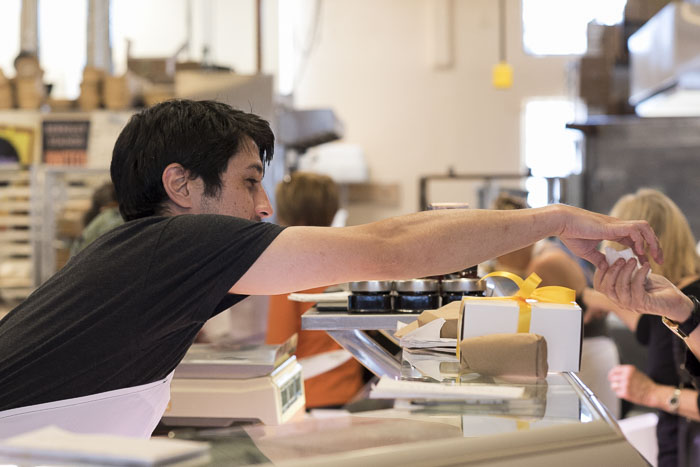Chez Panisse may be the superstar of Berkeley’s Gourmet Ghetto, but The Cheese Board was there first. Fifty years ago, a young couple opened a tiny shop in an alleyway in North Berkeley, stocking it with cheeses they selected by paging through a distributor’s catalog. The first day’s gross was $95. “You’re going to make it,” predicted an initially skeptical Alfred Peet, whose Peet’s Coffee was next door.
In 1971, The Cheese Board became The Cheese Board Collective when the couple sold the shop to their six employees. Amazingly, it thrives still, a vestige of that idealistic era. Today’s 60 members all make the same wage and have equal say in decisions. There is no hierarchy. Can you imagine?
In addition to the perpetually mobbed cheese counter with its 300 to 400 selections, the business now includes a wildly successful bakery, pizzeria and coffee bar. Longtime members Cathy Goldsmith (22 years) and Michael McGee (42 years) reminisced with me about the evolution of this landmark cheese counter and its customers.
Sorry about your anniversary party [canceled due to the Napa and Sonoma fires].
Goldsmith: We had a huge party planned but felt like we couldn’t do it. We were ready to give away 6,000 slices of pizza. I have a lot of tomatoes right now.
What’s it like to work here?
CG: The members range from 21 years old to maybe 73, and everyone is trained to do a lot of things. I’m community liaison and a barista, but I made all the doughs this morning and I’ll sell cheese all day tomorrow.
You all are famous for your patience. You’ll let customers sample until the cows come home.
CG: I did have a customer once, many years ago, who was celebrating her 32nd birthday and wanted to buy 32 tiny pieces of cheese. That took so long. She was just in recently and I said, “I waited on you!” You don’t forget that. All the pieces were, like, one-sixteenth of a pound, wrapped and labeled.
What do you remember about the early days at the cheese counter?
Berkeley’s best: Cheese Board cheese rolls
CG: We had a distributor who used to bring cheese in an old milkman’s truck. We would go out to the truck and pick our cheeses—like a pop-up today. There wasn’t much domestic cheese. We had Maytag Blue and Vella Dry Jack and Redwood Hill and probably Matos St. George. But it was so much cheaper to buy French cheese.
Top sellers today?
CG: Fromager d’Affinois. We sell a ton of it. Prima Donna Gouda. The newcomer that’s starting to rival it would be Prairie Breeze. It’s delicious, at a great price point and it has a Gouda quality to it. And at the holidays, everybody wants something with truffle in it.
Any idea how many pounds of cheese you move on a Saturday?
CG: No, but I once decided to have a staff contest to guess how much fresh mozzarella we were selling. Elizabeth, our founder, won. We were selling 300 tubs of imported mozzarella every two weeks. We go through a couple of (85-pound) wheels of Parmigiano-Reggiano a week. And we sell 150,000 English muffins a year.
Anything customers ask for that you don’t carry?
CG: Every once in a while, you get questions about Lemon Stilton. We don’t carry a lot of cheeses that have stuff in them. We don’t sell Sage Derby anymore. Or somebody might want a particular Gouda they had in Europe. We only carry 20 different kinds of Gouda, but maybe not that one.
So many co-ops have shuttered. Why is The Cheese Board still here?
McGee: It’s true that there were a lot of food co-ops in the ‘60s and ‘70s. Their desire at the time was to get inexpensive food for the people, which is a great notion but you’ve got to take care of your workers and have some business sense. They were rebelling against the mentality of running a business, and they ended up not making it. They used to consider us the bourgeois collective, but we’re still around and we’re still pushing cooperatives.
Any other secrets to your success?
MM: I’ve always said that one of the reasons is that every four or five years we decide to do something new. Otherwise, you start to get a little bored and sloppy and customers sense that. We started with cheese, then we started baking bread, then we decided to put bread and cheese together and make pizza. Then we realized that people were coming in to buy our pastries in the morning but going somewhere else for coffee, so we started making coffee. Each time we took a big step, it really stimulated all of us, including our customers. Another reason is that we’ve always believed in trying to enjoy our daily lives and increase the joy in our customers’ lives.






